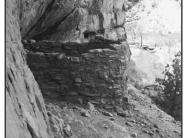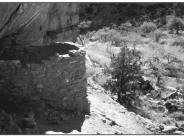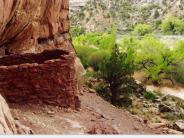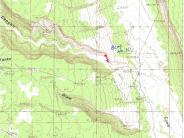Arch Canyon 1
ARCH CANYON
General Description: This photo-point is in Arch Canyon about 1/2 mile upstream from the fenced private land/BLM land boundary. The view is southeast and downstream across public land administered by the Bureau of Land Management.
Legal Description: NW1/4NW1/4 Section 25 T.37S., R.20E.
COMPARISON: The 1964 photograph was taken to illustrate a recently stabilized Anasazi structure. However, the photographer did capture a sufficient glimpse of the nearby stream to allow comparison. Although taken during the winter, it is still possible to view the wide, rocky, mostly non-vegetated stream channel that existed in 1964. By 1993 the channel has narrowed, built a new floodplain, and is beginning to reestablish sinuosity. The banks and floodplain are thickly vegetated with riparian species such as Fremont cottonwood, yellow willow, coyote willow, cattail, bulrush, common reed, horsetail, and rush and sedge species. This particular stream segment is in properly functioning condition. The 1993 image was taken prior to livestock removal from the Arch Canyon pasture in 1996.
| Original: Date: 1964 (- A) Photographer: Unknown Source: Bureau of Land Management, Monticello, Utah
Photograph Number: BLM No. 10 |
1993 Retake: Date: November 1993 (- B) Photographer: Earl Hindley Source: Bureau of Land Management, Salt Lake City, Utah |
2007 Data
2007 Retake:
Date: April 26, 2007
Photographer: Earl Hindley
Source: Earl Hindley
General Description: The photo-point is approximately one half mile upstream from the mouth of Arch Canyon. The view is downstream across Arch Canyon Creek.
Location: N. 37 32.902′ W. 109 40.416 (Lat./Long.)
Comments/Comparison: The riparian vegetation community at this point is becoming more densely populated, maturing and expanding laterally away from the main channel on both sides. The channel and banks appear to be mostly un-vegetated in 1964 but by 1993 a healthy riparian community was established, the channel had narrowed, was more sinuous and had established a flood plain. By 2007 willows, common reed (phragmites), cattail and rushes had grown to the point that the active stream channel was no longer visible from the photo-point as it was in 1993. High water flow during the fall of 2006 spread over most, if not all, of the flood plain at this point. New overflow channels were cut and a new main channel was established in an area just downstream from this site. However, significant sandy soil deposition was possible here due to the existing channel and flood plain vegetation. The narrowing of the main channel contributed to the flooding here because the narrower channel width could not contain the high water flow.
(Feb. 2007) Spring vegetation growth is evident in the phragmites or common reed community at the lower right of the April 2007 photograph. This specie and other riparian plants will continue to expand their habitat onto the floodplain on both sides of the main channel. (April 2007)




